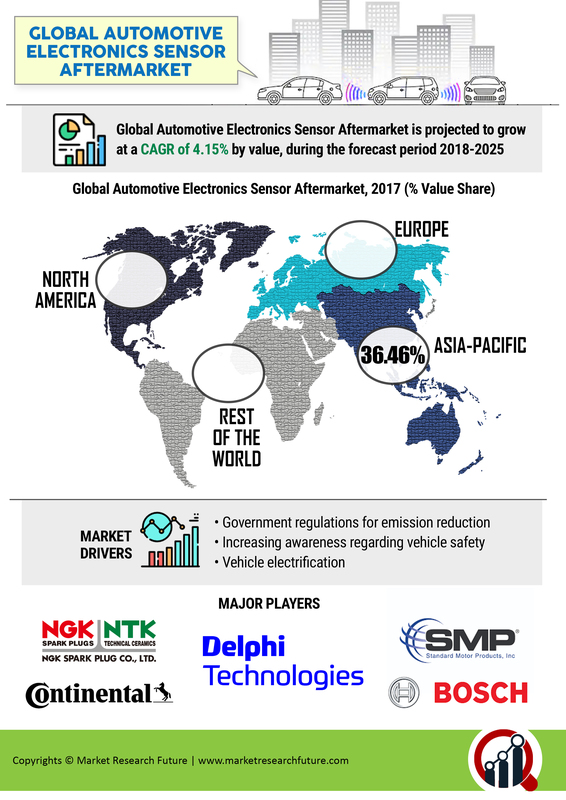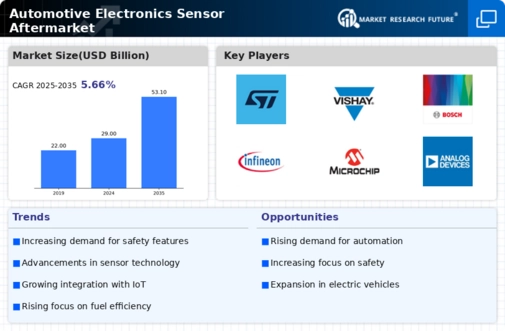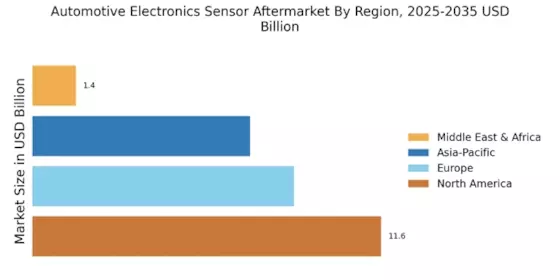Increasing Vehicle Electrification
The trend towards electrification in the automotive sector is reshaping the Automotive Electronics Sensor Aftermarket Market. As more manufacturers introduce electric and hybrid vehicles, the demand for specialized sensors that monitor battery performance, energy consumption, and thermal management is likely to rise. According to recent data, the electric vehicle market is projected to grow at a compound annual growth rate of over 20% in the coming years. This growth necessitates a robust aftermarket for sensors that can ensure optimal performance and safety in these vehicles. Consequently, the Automotive Electronics Sensor Aftermarket Industry is expected to expand significantly, driven by the need for advanced sensors that cater to the unique requirements of electric and hybrid vehicles.
Regulatory Compliance and Safety Standards
The Automotive Electronics Sensor Aftermarket Market is increasingly influenced by stringent regulatory compliance and safety standards. Governments worldwide are implementing regulations that mandate the use of advanced sensors for vehicle safety and emissions control. For instance, the introduction of new safety regulations may require the installation of additional sensors in vehicles to monitor various parameters. This regulatory landscape creates a substantial opportunity for the aftermarket sector, as vehicle owners and manufacturers seek to upgrade or replace sensors to meet compliance requirements. The market for automotive sensors is projected to reach approximately $30 billion by 2026, indicating a robust demand driven by regulatory pressures.
Expansion of the Automotive Aftermarket Sector
The overall expansion of the automotive aftermarket sector is a significant driver for the Automotive Electronics Sensor Aftermarket Market. As vehicle ownership rates increase and the average age of vehicles on the road rises, the need for replacement and upgraded sensors becomes more pronounced. The aftermarket sector is expected to grow at a steady pace, with estimates suggesting it could reach $400 billion by 2025. This growth is fueled by the increasing number of vehicles requiring maintenance and upgrades, thereby creating a robust market for automotive sensors. Consequently, the Automotive Electronics Sensor Aftermarket Industry stands to benefit from this expansion, as more consumers turn to aftermarket solutions for their vehicles.
Technological Advancements in Sensor Technology
Technological advancements are a key driver in the Automotive Electronics Sensor Aftermarket Market. Innovations in sensor technology, such as the development of more accurate, reliable, and cost-effective sensors, are likely to enhance the performance of vehicles. The integration of artificial intelligence and machine learning into sensor systems is also expected to improve data processing and decision-making capabilities. As vehicles become more sophisticated, the need for high-performance sensors that can support advanced functionalities will increase. This trend suggests that the aftermarket for automotive sensors will experience growth, as consumers and manufacturers alike seek to upgrade their vehicles with the latest sensor technologies.
Rising Consumer Demand for Vehicle Customization
Consumer preferences are shifting towards vehicle customization, which is significantly impacting the Automotive Electronics Sensor Aftermarket Market. As drivers seek to personalize their vehicles with advanced features, the demand for aftermarket sensors that enhance performance, safety, and connectivity is likely to grow. This trend is particularly evident in the rise of aftermarket modifications, where consumers install additional sensors for improved functionality. The market for automotive aftermarket products, including sensors, is projected to reach $100 billion by 2025, indicating a strong consumer inclination towards enhancing their vehicles. This growing demand for customization presents a lucrative opportunity for the Automotive Electronics Sensor Aftermarket Industry.


















Leave a Comment